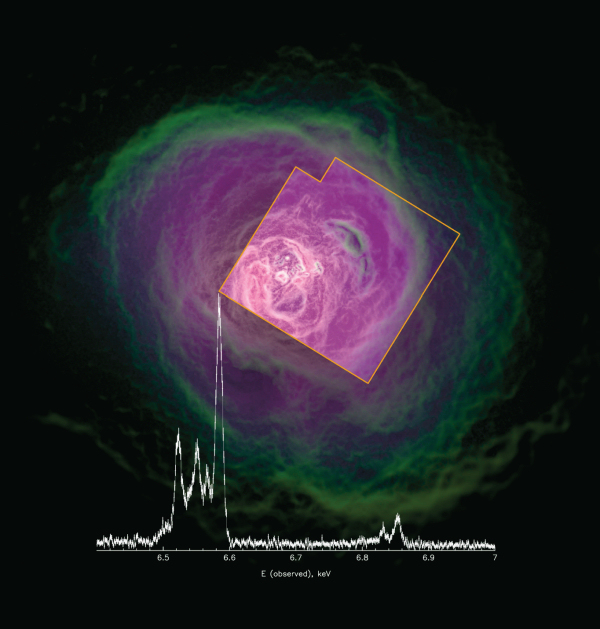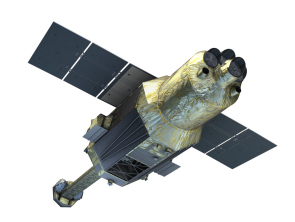Galaxy cluster keeps calm and carries on radiating X-rays
6 July 2016
With its very first observation, the Hitomi X-ray observatory has discovered that the gas in the Perseus cluster of galaxies is much less turbulent than expected. This is a surprise because the Perseus cluster is home to NGC 1275, a highly energetic active galaxy.
 |
| X-ray view of the Perseus cluster. Credit: Background: NASA/CXO; Spectrum: Hitomi Collaboration/JAXA, NASA, ESA, SRON, CSA |
The result allows the mass of the Perseus cluster to be calculated more accurately than before. Once this technique can be extended to other clusters, it will allow cosmologists to use them as better probes of our models of the Universe's evolution from the Big Bang to the present time.
Hitomi (originally known as ASTRO-H) is the sixth in a series of Japanese X-ray observatories. Led by the Japan Aerospace Exploration Agency (JAXA), it is a collaboration of over 60 institutes and 200 scientists and engineers from Japan, the US, Canada, and Europe. The spacecraft was launched on 17 February 2016 from the Tanegashima Space Center, Japan.
"Hitomi targeted the Perseus cluster just a week after it arrived in space," says Matteo Guainazzi, ESA Hitomi Resident Astronomer at the Institute of Space and Astronautical Science, Japan. "Perseus is the brightest X-ray galaxy cluster in the sky. It was therefore the best choice to fully demonstrate the power of the Soft X-ray Spectrometer (SXS), an X-ray micro-calorimeter that promised to deliver an unprecedented accuracy in the reconstruction of the energy of the incoming X-ray photons." Waiting astronomers were not disappointed.
The Hitomi collaboration found that SXS could measure the turbulence in the cluster to a precision of 10 kilometres/second. But it was the absolute velocity of the gas that took them by surprise. It was just 164 ± 10 kilometres/second along the line-of-sight. The previous best measurement for Perseus was taken with ESA's XMM-Newton X-ray observatory. Using a different type of spectrometer, it could only constrain the speed to be lower than 500 kilometres/second.
Hitomi's measurement is therefore much more precise than any similar measurements performed in X-rays so far. "This is due to the outstanding performance and stability of the SXS in space. This demonstrates that the technology of X-ray micro-calorimeters can yield truly transformational results," says Guainazzi.
 |
| Hitomi satellite. Credit: JAXA |
The result indicates that the cluster gas has very little turbulent motions within. Turbulent motions in a fluid are part of our everyday life, as airplane passengers, swimmers, or parents filling a bathtub all experience. The study of such chaotic behaviour is also a powerful tool for astronomers to understand the behaviour of celestial objects.
Turbulent energy in Perseus is just 4 percent of the energy stored in the gas as heat. This is extraordinary considering that the active galaxy NGC 1275 sits at the heart of the cluster. It is pumping jetted energy into its surroundings, creating bubbles of extremely hot gas. It was thought that these bubbles induce turbulence, which keeps the central gas hot.
Hitomi shows that turbulent motion is almost absent from the cluster, and this gives rise to a mystery: what is keeping the cluster's widespread gas hot?
"This result from Hitomi is telling us that in terms of how cluster cores work, we have to think very carefully about what is going on," says Andrew Fabian, University of Cambridge, UK, and part of the Hitomi collaboration.
Fabian is working on the possibility of sound waves as the means of spreading the energy evenly throughout the gas. This is because in a sound wave, energy can be moved while the medium itself remains more or less stationary.
There are wider implications for this work too. Clusters of galaxies are the largest bound structures in the Universe. At the same time, they are also the smallest self-contained 'boxes'. This means that matter is not flowing in or out of a cluster of galaxies. Instead, they each represent an island in which cosmic evolution has played out and been recorded.
Computer models of the expanding Universe use the distribution of cluster masses as an observational test of whether they are correct. Calculating the mass of a cluster depends upon the ratio of turbulent to quiescent gas. Any way of more accurately measuring turbulence allows better masses to be calculated, and therefore better computer models of the whole Universe to be developed.
Unfortunately, just a few weeks after the Perseus observation, a malfunction in the attitude control system put Hitomi into an uncontrollable spin that resulted in the break up and loss of the satellite.
"It is really disappointing that we have lost Hitomi and can't go on with the programme that we had to look at many more clusters," says Fabian.
The next mission that will be capable of fully following up the Hitomi programme is ESA's Athena, an X-ray observatory scheduled for launch in the 2020s.
"Scientifically and technically, the Hitomi results are an exciting foretaste of Athena," says David Lumb, ESA's Athena Study Scientist. "The demonstration of a radically new imaging spectrometer instrument concept gives huge confidence for future developments for Athena."
Athena will have 100 times more collecting area and 100 times more pixels than Hitomi. Among the key scientific objectives of Athena are to investigate the evolution of clusters of galaxies including their interplay with energy injection from supermassive black holes.
"The Hitomi data show the potential that will be unleashed with Athena vastly increased imaging capability and sensitivity," concludes Lumb.
More information
"The quiescent intracluster medium in the core of the Perseus cluster" by the Hitomi collaboration is published in the 7 July issue of Nature; doi:10.1038/nature18627.
The Hitomi satellite (known as ASTRO-H prior to launch) was an international X-ray observatory, extending also to soft gamma-ray energies, developed by the Japan Aerospace Exploration Agency (JAXA) in collaboration with institutions in Japan, the US, Canada, and Europe. It was launched on 17 February 2016 from the Tanegashima Space Center, Japan. On 28 April 2016, JAXA announced that they would discontinue operations of Hitomi as it was no longer possible to communicate with the satellite following an anomaly that appeared to have resulted in both solar array paddles having broken off from the spacecraft body.
ESA contributed to the Hitomi mission by partly funding various elements of the four science instruments, by providing three European scientists to serve as science advisors and by contributing one scientist to the operations team in Japan.
The SXS X-ray micro-calorimeter was developed and built by scientists from NASA's Goddard Space Flight Center, working closely with colleagues from several institutions in Japan,
Athena is an advanced telescope for high-energy astrophysics, selected by ESA as its second 'Large-class' science mission. By combining a large X-ray telescope with state-of-the-art scientific instruments, Athena will address key questions in astrophysics, including: how and why does ordinary matter assemble into the galaxies and galactic clusters that we see today? How do black holes grow and influence their surroundings. Launch of Athena is foreseen in 2028.
Contacts
Andrew Fabian
University of Cambridge, UK
Email: acf![]() ast.cam.ac.uk
ast.cam.ac.uk
Matteo Guainazzi
ESA Hitomi Resident Astronomer
Institute of Space and Astronautical Science, Japan
Email: mguainaz![]() astro.isas.jaxa.jp
astro.isas.jaxa.jp
David Lumb
ESA Athena Study Scientist
Directorate of Science, European Space Agency
Email: david.lumb![]() esa.int
esa.int


